What is B2B Marketing?
Definition, strategy, and examples of business marketing
B2B (Business-to-Business) Marketing uses marketing strategies, tactics, and content tailored specifically to market a product or service to other companies. Unlike B2C, where businesses sell to individual consumers, B2B focuses on selling to other companies.
But what exactly is B2B, and how does it differ from B2C marketing? We define Business marketing and show differences and similarities to consumer marketing.
We take you through a 7-step approach to creating your own powerful B2B marketing strategy.
We’ll explore the marketing mix, dive into various marketing channels, and provide real-world examples of successful business marketing strategies and tactics.
Welcome to the exciting world of B2B Marketing!
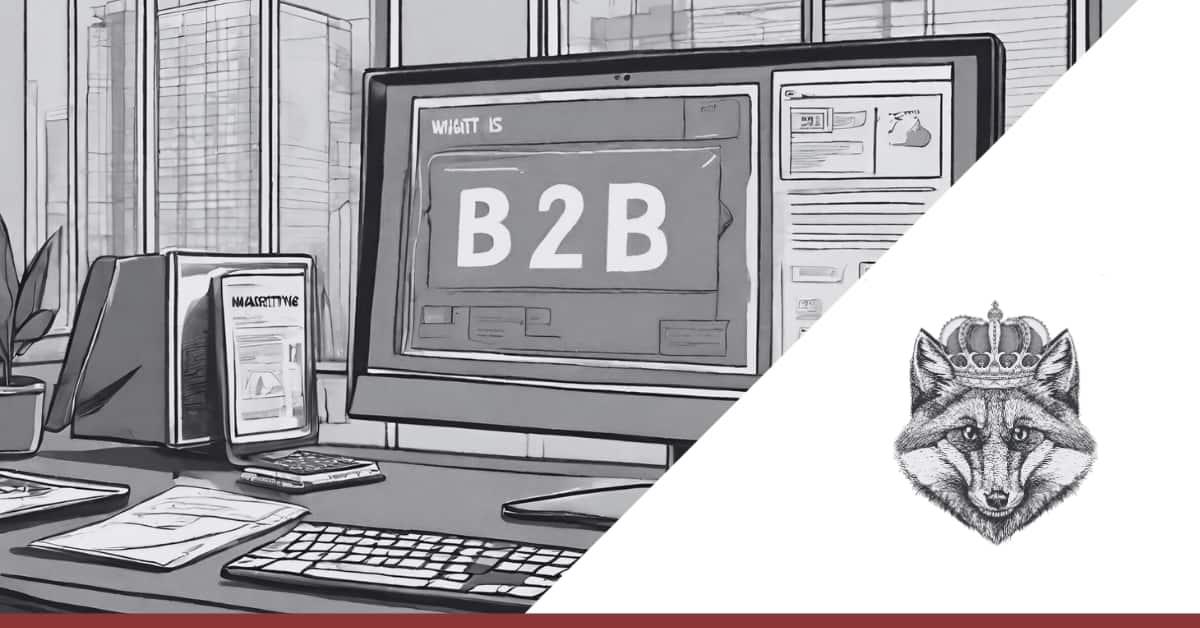
3 Article Highlights
Table of Contents
Table of Contents
Newsletter
Subscribe and Learn B2B Marketing.
What is B2B Marketing?
Definition of Business-to-Business Marketing
Definition of B2B Marketing
B2B (Business-to-Business) Marketing uses marketing strategies, tactics, and content tailored specifically to market a product or service to other companies. In contrast to consumer marketing (B2C Marketing), which targets individual consumers, B2B marketing focuses on businesses.
Other terms commonly used to describe B2B marketing are industrial marketing, business marketing, or B2B industry marketing. These terms are synonymous and reflect the same marketing discipline.
A core aspect of marketing is the relationship between a company and its target audience.
Therefore, the type of target audience (business vs. consumer) categorizes marketing:
- Customer is a business = B2B marketing
- Customer is a consumer = B2C marketing
B2B marketing aims to create value for the customer and your business. The aim is to convert this value into leads, sales opportunities, and turnover.
What is B2B Marketing © B2B Marketing World
B2B marketing is a modern term, but marketing for other companies started during the Industrial Revolution in the 18th century.
The oldest content marketing example is from 1985. The American manufacturing company John Deere published “The Furrow,” a customer magazine. Sounds interesting? Here’s the rest of the content marketing story.
The Importance of B2B Marketing
B2B marketing is increasingly important as the B2B market itself is growing. Statistics forecast an increase of 69% in B2B advertising spending till 2024. B2B Marketers will spend 79% more on marketing technology by 2024 than they used to in 2020.
These statistics underline the importance of B2B marketing:
- The B2B trade show market in the U.S. had a value of $11.8 billion in 2023 and is forecast to grow to $14.7 billion by 2027 (Statista)
- The Gross Merchandising Volume (GMV) of Amazon Business will continue to grow to $83.1 billion by 2025 (Statista)
- In Europe, the B2B eCommerce GMV will reach $1,817 billion in 2025 (Statista)
What is Marketing?
For a better understanding of marketing for businesses, it is necessary to have a closer look at the term marketing itself.
Marketing is the action or business of promoting and selling products or services, including market research and advertising.
This is a simple but accurate definition. Modern marketing includes many specific disciplines. Examples are Content Marketing, Social Media Marketing, Digital Marketing, Newsletter Marketing, account-based marketing, and other offline and online marketing disciplines.
The classic definition by Jerome McCarthy, made in 1960, uses the “4P” concept. Also called the marketing mix:
- Product or Service
- Price
- Place or Distribution
- Promotion or Communication
The godfather of marketing, Philip Kotler, has defined marketing as “a social and managerial process by which individuals and groups obtain what they want and need through creating, offering, and exchanging products of value with others.”
Marketing has a strategic importance for your company. It, therefore, “aims to deliver standalone value for prospects and consumers through content, with the long-term goal of demonstrating product value, strengthening brand loyalty, and ultimately increasing sales (Hubspot).”

Philip Kotler © Wikimedia Commons
These definitions outline a central topic of marketing: customer-centricity. The aim is to please your customers and add value. Reaching your target audience is at the heart of all marketing.
This aspect is essential for marketing in the business-to-business environment.
B2B relationships are, as the name implies, relationships between two companies. They are important as B2B relationships are long-lasting and build on mutual trust. B2B marketing focuses on establishing, maintaining, and using these relationships.
Business to Business Marketing
The B2B Marketing Process and Differences to Consumer Marketing
Marketers employ different strategies to convert potential buyers into loyal customers. The buyer’s journey and the marketing funnel concepts are valuable frameworks in B2B marketing.
Additionally, we analyze the similarities and differences between B2B and B2C marketing.
The B2B Marketing Process
An essential part of your B2B marketing efforts is providing your target group with the right information exactly when needed.
The buyer’s journey is the process a potential buyer goes through before buying from you. Some concepts also include the after-sales phase to retain a customer and make him buy again.
There are 4 steps of the B2B marketing process:
- Awareness stage
The prospect realizes a need and wants to find a solution to his problem. - Consideration stage
Your potential buyer considers different solutions for his problem. He compares other companies, products, or services and starts to rank them. - Decision stage
The buyer makes the purchase decision based on the best solution for the best value/cost. - Retention stage
Your new customer reasons if the purchase was a good deal. If he is satisfied, he is likely to buy from you again. You aim to retain him as a loyal customer.
B2B Marketing Process © B2B Marketing World
There is another way to show these 4 phases. From top to bottom, the funnel concept claims to convert from awareness to retention by using the top-of-funnel (TOFU), middle-of-funnel (MOFU), and bottom-of-funnel (BOFU) phases. The final stage, after purchasing, is the retention phase.
B2B marketers use different marketing strategies, tactics, and channels in each phase.
B2B vs. B2C Marketing
The distinct factors of B2B and B2C Marketing are the market and, ultimately, the targeted customer. B2B Marketing happens in a business market between two companies, whereas B2C Marketing happens in a consumer market.
But why is this important?
B2B goods differ from consumer goods, as do the market mechanisms.
The most apparent aspect is the customers. Selling to an individual is one thing, but selling to another company is an entirely different story.
So yes, there are differences between the two marketing disciplines.
Some claim that we are all humans. Therefore, claiming that all marketing is “Human-to-Human” or “H2H” marketing is sufficient.
Look at it from this perspective: We are all humans. True. We all wear clothes. True. It is sufficient to market a suit the same way as a bikini. False. Although similar mechanisms help your marketing in both cases, there’s still a different approach to it.
The same logic applies to consumer clothing versus industrial machinery. The same marketing tactics can be effective in both B2C and B2B markets.
Successful B2B marketing understands how to tailor them to the industrial sector.
As an overview, we compare some typical, market-defining criteria: target group, number of people involved, and the 4Ps of marketing. If you want a complete breakdown, here’s an article on B2B vs. B2C Marketing.
| B2B Marketing | B2C Marketing | |
|---|---|---|
| Target Group |
|
|
| Number of people involved |
|
One person makes the decision, often consulting friends or family to:
|
| Product / Service |
|
|
| Price |
|
|
| Place / Distribution |
|
|
| Promotion / Communication |
|
|
B2B Marketing Infographic
This B2B marketing infographic outlines the topic in a nutshell.
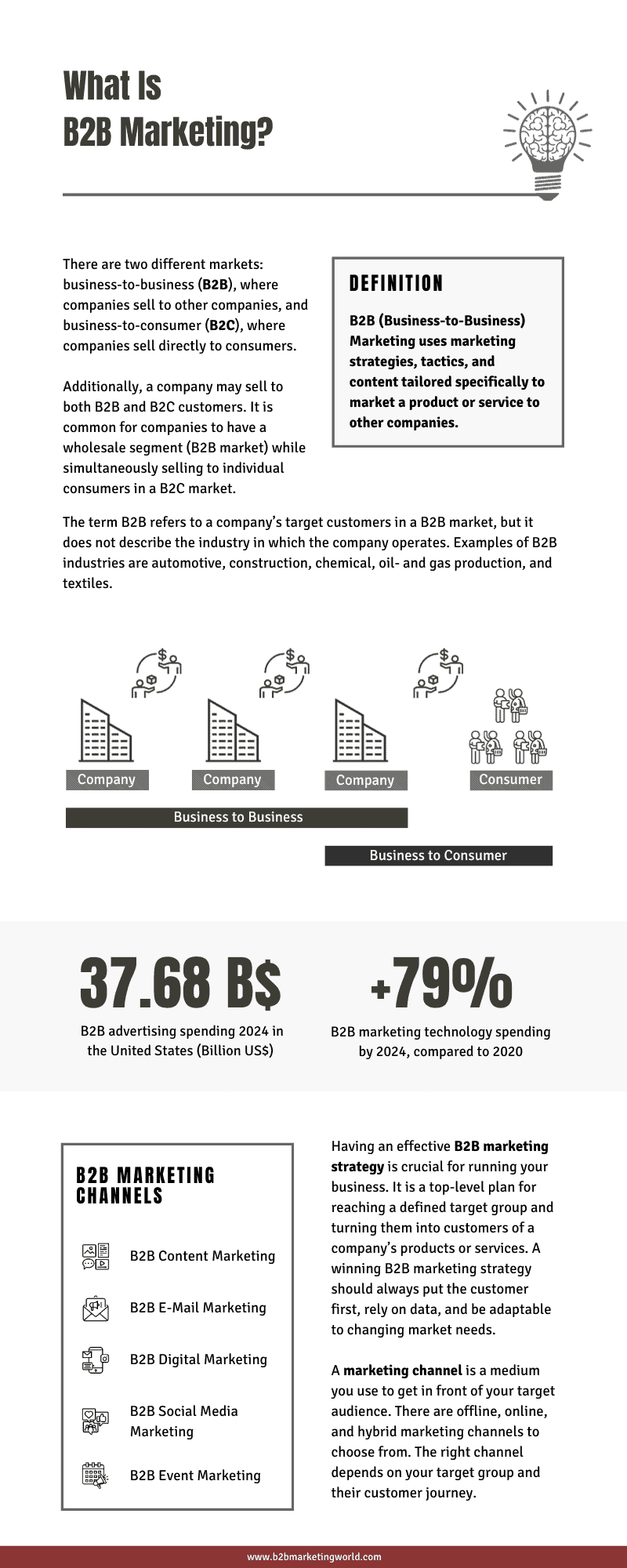
What Is B2B Marketing [Infographic] © B2B Marketing World
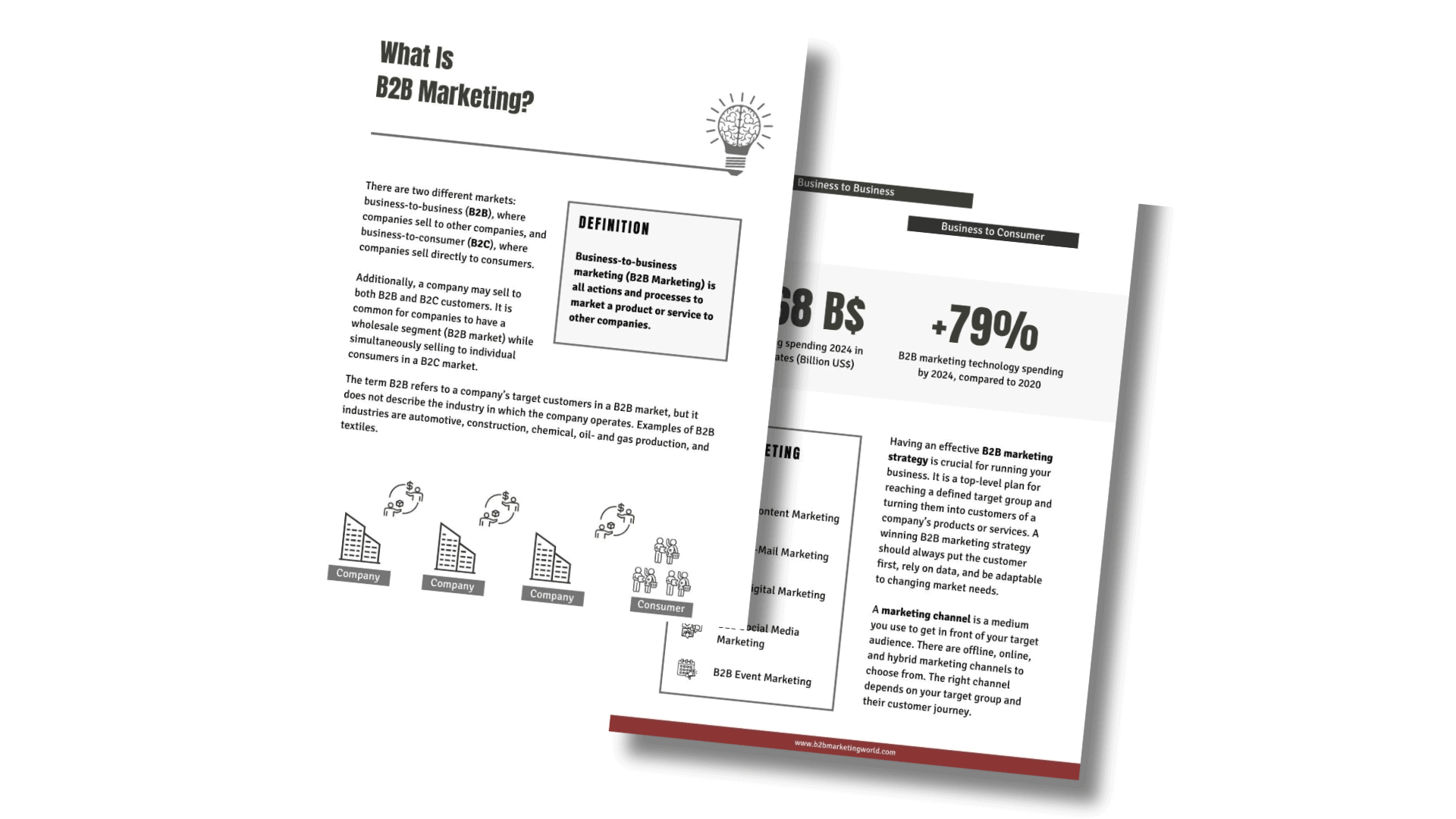
Download this free Infographic!
B2B Marketing Strategy
Your Marketing Strategy in 7 Steps
This step-by-step approach helps you to create your business marketing strategy.
Chapter Overview
An effective B2B marketing strategy is crucial for running your business. It is a top-level plan for reaching a defined target group and turning them into customers of a company’s products or services.
You must understand your target market and consistently connect with your target group.
The key is to create clear value propositions and deliver them efficiently with marketing communication.
A winning B2B marketing strategy should always put the customer first, rely on data, and be adaptable to changing market needs.
Companies with a marketing-centric approach view the marketing strategy as equally important to other key strategies such as sales, go-to-market, digitalization, and product strategies.
But why is a strategy important? Let us use this metaphor:
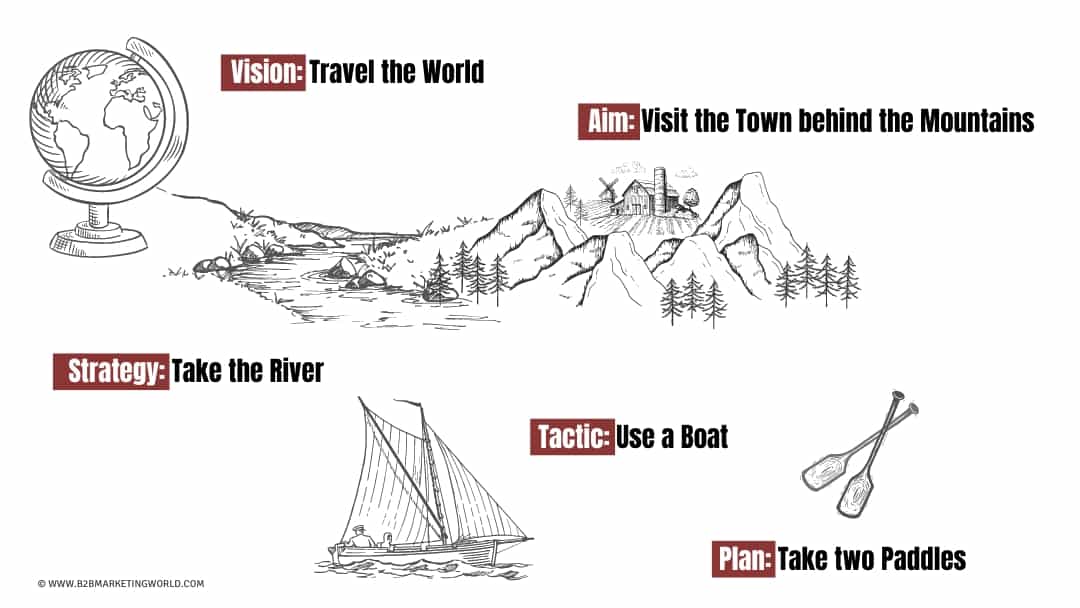
B2B Marketing Strategy © B2B Marketing World
The aim is to reach the town behind the mountain. Flying over the mountains could be a suitable strategy. Would the tactic of using a boat be effective for the strategy of flying? Obviously not.
Alternatively, although you want to use your boat, no river might be suitable to sail. In this example, your strategy fails to contribute to the desired outcome. Your boat might be perfect, but the aim remains unfulfillable as your tactic fails.
Step 1: Brand Positioning
You must define, create, and implement your brand’s positioning to create an effective strategy. This step is important as it shapes how customers perceive your brand.
Brand positioning includes the who, when why, and how of your company’s brand identity.
It involves identifying the unique value proposition of your brand.
By strategically positioning your brand, you can differentiate yourself from competitors. And establish a strong market presence to create lasting connections with your customers.
Step 2: Definition of Aims
Define a clear goal. This is a necessary step toward developing a long-term strategy.
The marketing objective is derived from the sales goals. A logical and hierarchical aim structure ensures that all marketing actions contribute to the company’s success.
The goals should be specific and measurable so you don’t waste time and money on marketing that doesn’t drive results. SMART aims are:
- Specific
- Measurable
- Attractive
- Realistic
- Terminated
Examples of good and bad formulated marketing aims:
Examples of good and bad aims
Formulate aims that feel natural and contribute to your marketing idea. Don’t just put anything in writing because literature (and this article) tells you so.
Trust me, aims are worth the time and struggle.
Step 3: Understand your B2B Buyer’s Journey
A buyer’s journey is the process buyers undergo, from awareness to purchase. The classic definition includes four journey steps: Awareness, Consideration, Decision, and Retention.
In today’s digital landscape, with many social media channels and complex customer behavior, the buyer’s journey is no longer linear.
Further, the journey is impossible to track.
No B2B buyer ever googled, read your website, filled out a contact form, and accepted your offer in exactly this order.
Reality is much more complex, especially in B2B markets.
This step is, therefore, probably the most critical one. You need to understand your buyer’s journey. Otherwise, you will not be able to target.
Step 4: Define your Target Market and Target Group
The target group definition derives from the aims and connects with the buyers’ journey.
The ideal target group is as homogenous as possible and has distinct criteria that separate it from other target groups.
It is vital to have a clear segmentation for your marketing campaigns.
Modern target group definitions focus on customer needs instead of purely demographic or geographic criteria. These data include:
- Age and Gender
- Location and Language
- Education Level
- Job Title and Employer
- Behavior, Habits, and Beliefs.
For online campaigns, firmographic data is a helpful approach. This data shifts focus on businesses. Examples include:
- Industry, e.g., manufacturing, legal services, automotive
- Company size, e.g., in terms of employees or turnover
- Location, including local subsidiaries for individual local market demands.
Step 5: Choose your Marketing Mix and Marketing Channels
The next step in your strategy creation is defining how to reach your target group best.
The well-known 4Ps of Marketing is the foundation and also named marketing mix:
- Product: what product or service you sell
- Price: how much it cost
- Place: how the product is distributed and where it is sold
- Promotion: how the product or service is communicated and advertised
Marketing channels connect you with your customers. Channels include online and offline examples:
- Websites and Industry Blogs
- Social Media
- Newsletter
- Podcasts and Webinars
- Print Magazines
This step connects the information about your target group with your company and portfolio specifics. It sets the scene for creating an actionable marketing plan.
Step 6: Create a Marketing Plan
Understanding the distinction between a marketing strategy and a marketing plan is essential: it is actionable and focused on the short term.
Develop your marketing plan based on your marketing mix.
Typically, B2B marketing plans are designed for a one-year budget period. Within your marketing plan, it’s crucial to address the following question: “How can we deliver the right information to the right people through the right channels, using the right assets at the right time, to achieve our defined goal?”
Let’s have a closer look:
- The right time: Depending on the buying journey stage.
- The right information: Tailored information in an appropriate format (the right asset)
- The right channels: Different channels may be more effective depending on the information and asset. Timing is also crucial.
- The right people: Your target group or buying persona
By connecting the information gathered, you can create a practical marketing plan.
Step 7: Define Marketing KPIs
Make your marketing measurable. Measure and report each activity to ensure the effectiveness of your marketing campaigns.
Use marketing data to optimize your campaigns and increase efficiency. This data provides valuable insights into the success of your campaigns. It allows you to make informed decisions.
The interpretation of this data serves as input for analyzing your objectives and further in-depth analysis.
With this approach, your B2B Marketing strategy becomes a closed-loop process. Every step is evaluated and used as input for improvement.
B2B Marketing Channels
How to Reach Your Customers
A marketing channel is a medium you use to get in front of your target audience. There are offline, online, and hybrid marketing channels to choose from. The right channel depends on your target group and their customer journey.
The following is a brief overview of different B2B Marketing channels:
As described above, the marketing plan combines assets and channels. During your analysis phase, you see which channel your competition uses and where to find your audience. Multiple channels are used in a cross-channel marketing approach.
Communication channel management analyzes, decides, manages, and evaluates marketing channels.
B2B Content Marketing
Traditional PR and marketing advertisement strategies aim to catch a consumer’s attention with promotional material and news.
Content marketing strategies deliver valuable information and seek to help the consumer instead of convincing him. B2B content marketing educates and solves your target group’s problem.
Further, content marketing positions your business as an expert in your industry. This B2B content marketing strategy is also called Thought Leadership. The idea is to become the go-to resource and named expert for a topic. You create trust, ultimately leading to credibility and building the foundation for long-term partnerships.
Yet again, the most successful content marketing is aligned with the buying journey. The specific pain point of each phase needs different content types and assets. A content marketing plan outlines your tactic to deliver this exact content at the right time.
Some assets and formats work better than others on specific channels.
For example, you wouldn’t use an image slideshow on YouTube. Or publish a long text on a print ad.
This might be an obvious thing to say. But, the wrong asset choice is a common pitfall in modern business marketing.
B2B content formats are:
- Whitepapers and eBooks
- Case Studies
- Webinars
- Templates, Checklists, and How-to-Guides
- Tools and Calculators
- Learning Courses
- B2B Podcast
B2B E-Mail Marketing
Nearly everyone (99%) checks their email daily, making newsletters the go-to content marketing strategy for 81% of B2B marketers. These statistics underscore the importance of newsletters.
Email marketing stands out as one of the most powerful channels for B2B marketing. It can consistently drive traffic to your website, all while being cost-efficient and user-friendly. The most significant advantage of email marketing lies in your control over the channel—your owned media.
Still, people have learned that newsletters are likely to be spam. This is an unfortunate result of thousands of B2C e-mails we nowadays associate with unwanted advertisements.
Your B2B e-mail newsletter, therefore, needs to fulfill these criteria:
- Value adding. A newsletter is no promotional tool. As we just mentioned, content marketing in B2B is about delivering constant value and educating your audience.
- Have a defined sending frequency and tell your subscribers when to expect your newsletter. Stick to it and become a part of their routine.
- Make sure to send multiple newsletters if you have multiple target groups. The one-fits-all newsletter does not exist.
- Responsiveness. Mobile first. Many users access their inboxes using mobile phones. E-mails that fail to display correctly on mobiles are likely deleted.
B2B Digital Marketing
There’s no denying it. Digital marketing is vital for B2B marketing.
Over 80% of buyers visit a website before making a purchase. A modern prospect is well-informed before the first personal contact with sales. Most people educate themselves online. Google processes over 100,000 searches per second.
Your website is at the center of it all. A company website is your digital hub and leads all marketing activities. Your digital appearance supports your brand, raises awareness, informs your target group, is a platform for engagement, generates leads, and users can purchase in your B2B eCommerce shop.
Beyond business, your website also covers jobs and career, corporate social responsibility, and sustainability. Your website is vital to your digital universe across all company topics.
Your company needs to take advantage of the digital world. B2B tends to have mediocre online marketing strategies. You aim to be among those B2B companies using digital marketing potential.
B2B Social Media Marketing
Social media is a super powerful tool for building brand awareness, giving your company an online personality, and humanizing your business. These factors are essential when it comes to connecting with potential customers.
In a nutshell, there is no way to avoid social media for B2B marketers. The times when social media marketing was used in B2C only are long gone.
Establish your unique social voice. Be authentic, honest, and entertaining. At the same time, you are focusing on creating value for your company and your audience.
Here are some examples of social media marketing in B2B:
LinkedIn has 840 million users and is expected to grow to over a billion users by 2025 (Statista 2022). The largest business network is the best way of leveraging your marketing with social platforms.
Facebook is still a good channel for branding and human resources topics.
YouTube is, without a doubt, the most significant player in the video market. Instagram can be used for brand-related, visual storytelling.
And TikTok is the fastest-growing social media platform worldwide.
B2B Event Marketing
Industry events, exhibitions, congresses, and trade shows are still a common marketing channel in B2B. The B2B trade show market’s revenue worldwide reached an all-time high of 65 billion $ in 2021 as a post-pandemic rebound effect. A decrease to a pre-pandemic level of 4 billion dollars is expected in 2026, according to Statista.
But why is event marketing important in Business-to-Business?
The answer is simple.
Business relationships rely strongly on trust and aim for long-term partnerships. Industry events are a platform for networking, exchange, and business negotiations.
Service-centric business offerings rely on publications and public speaking. Industry events are commonly used to publish the newest technological findings and solutions.
B2B Marketing Trends 2024
What to Expect in Business-to-Business Marketing
There are countless predictions and opinions out there. Some are reliable, some are not.
That is why we rely purely on data and facts for our business marketing trends for 2024.
It is not that fancy and full of buzzwords, but it is reliable:
1.) Marketing advertising budget is spent online
Most of the marketing advertising budget (65%) will be spent online. Offline media remains to have value for specific niches but has a minimal budget share (<5%). (Statista)
2.) Mobile advertising continues to grow
Not only does the ad market continue to grow, but the budgets will also be spent on mobile advertising. (Statista)
3.) Face-to-Face events increase
Networking and personal, face-to-face contact remain vital to B2B marketing efforts. In the next year, the business event market will go back to pre-pandemic level. (Statista)
4.) The CMO role gains importance
CMOs will have a more direct role in driving revenue and growth. This increases the importance of the role and makes the CMO a valuable board member. (LinkedIn B2B Benchmark Report)
5.) Increasingly, B2B organizations are recognizing the importance of branding
As an essential task of marketing teams, brand building has become increasingly important due to the challenging global market environment. (LinkedIn B2B Benchmark Report)
6.) Generative AI
There’s no denying it. Generative AI is a major trend throughout all marketing disciplines and markets. The biggest impact for B2B marketing lies with content marketing, chatbots, and coding. (LinkedIn B2B Benchmark Report, eMarketer)
7.) The global rise of B2B Influencers
Like in many cases – what has worked in B2C marketing is likely to be adopted by B2B marketers, too. B2B influencers will play an increasingly important role in 2024.
93% of CMOs plan to increase their usage of B2B influencers to hyper-target marketing and personalized messaging. (Ogilvy)
8.) eCommerce in B2B is here to stay
If in doubt, change your mind. Online B2B sales are already and will continue to grow in 2024. A forecast says we see an increase in US B2B eCommerce site sales from $1.676 trillion in 2022 to $2.472 trillion in 2026. This is a plus of over 47% (eMarketer)
B2B Marketing Examples
Learn from Others
Now that we’ve explored the core principles and strategies of B2B marketing let’s delve into some real-world applications of these concepts. This section showcases how companies have successfully applied B2B marketing strategies and tactics. These examples are from various industries and marketing channels, offering a holistic view of B2B marketing in action.
Content Marketing, Animation and Videos: Animagraffs
Animagraffs showcases how complex topics can be explained visually. The animated content aims to educate the target audience and support fact-based content.
The content is designed as images or infographics or is animated as .gif or video.
This content explains the operational concept of a product, which is particularly valuable when customers are seeking solutions and looking for “how-to” or “what is” information.
For instance, a company specializing in a specific loudspeaker component could effectively promote their solution to renowned brands like Bose or Sony by addressing questions such as “How do speakers produce sound?”
Marketing Automation: Canon Austria
The Austrian division of the renowned global action brand Canon implemented marketing automation as a new method of sending corporate newsletters. 60,000 subscribers within five business segments faced a big change in marketing approach back in 2017.
This example shows how the marketing team of Canon Austria managed this change in 6 steps. From shock and denial to hope and enthusiasm and ultimately to successful integration.
Business Influencer on LinkedIn: Samson AG
This case is all about how LinkedIn has the power to boost the profiles of energy executives and truly capture the essence of trust-centric branding.
It’s about creating authentic Energy Influencers and witnessing the brilliance and radiance of executives as the driving force behind this exciting new era of B2B Marketing.
Through the eyes of B2B Marketers for LinkedIn, the story describes how Samson realized the need for a voice and channel to participate in the discussion.
From this first realization, towards the successful implementation.
Educational Content Marketing: Lincoln Electric
Lincoln Electric effectively showcases its capabilities to specific industries and applications through various B2B marketing techniques.
They utilize case studies, technical whitepapers, guidelines, and in-depth examples to demonstrate how their products solve real-world challenges.
By leveraging these strategies, Lincoln Electric has established itself as a trusted provider of welding equipment and supplies in the market.
Have a look at their “Education Hub.”
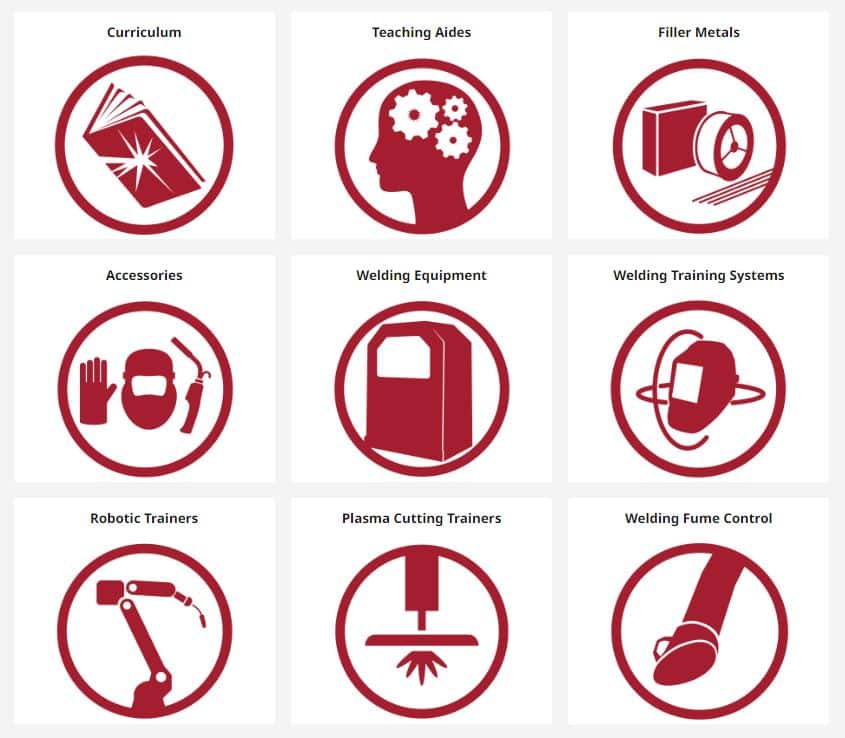
B2B Marketing Example “Education Hub” © Lincoln Electric
Newsletter Marketing: Asana
Regarding B2B software, the initial experience of demos determines whether you’ll like it or not. If usability is poor or you’re unsure where to start, you may never return. Asana overcomes this hurdle by sending a helpful welcome newsletter covering three simple steps:
- Create a task
- Update a due date
- Complete a task
This user activation keeps Asana in the game. It’s not commercial or spammy but a useful newsletter with clear call-to-actions.
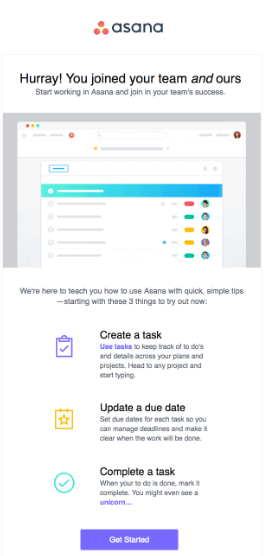
B2B Marketing Example: Newsletter © Asana
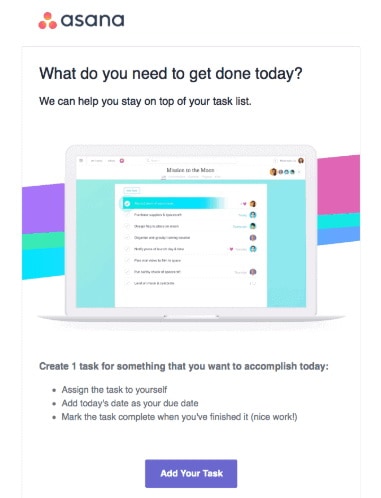
B2B Marketing Example: Newsletter © Asana
E-Book
Read and Download this B2B Marketing E-Book
Frequently Asked Questions
Find Answers to the Most Important Questions
B2B (Business-to-Business) Marketing uses marketing strategies, tactics, and content tailored specifically for businesses and organizations. Companies that offer products or services to other businesses or organizations rather than consumers rely on B2B Marketing.
B2B stands for Business-to-Business and describes interactions between two companies. In contrast to B2C, which stands for Business-to-Consumer relations.
B2B marketing focuses on a positive business relationship between two companies. B2C aims to influence consumers to buy from a company and establish long-term customer loyalty. The main differences are that B2C prices are lower, more people are involved in B2B buying decisions, products and services are more complex in B2B, B2C communication is, by trend, more emotionally driven, and distribution is more complex for B2B goods.
Business-to-business or B2B has multiple implications for marketing. B2B products are typically complex and, therefore, need fact-based and educational content. Target groups are heterogeneous, as numerous people are involved in buying. Prices are rarely displayed online and individual to projects. Communication in B2B tends to be less emotionally driven compared to consumer marketing. However, marketing essentials such as branding and digital and social media marketing are also essential strategies in business marketing.
Business-to-Business marketing examples are every time a company markets a product or service to another company. Examples are HP and Epson, which sell office printers. Microsoft sells Microsoft 360 to your company. A logistic company purchases a truck from MAN. Dell purchases NVIDIA graphic cards. But also, when Haribo purchases sugar from, or a steal manufacturer buys iron ore as raw material. All these transactions between companies include B2B Marketing.
Amazon is active in both business markets and consumer markets. Therefore, Amazon has B2B relations with other companies, e.g. when a company purchases office material from Amazon. As well as B2C relations whenever a consumer orders on Amazon.
A B2B Marketer works in a Business-to-Business marketing team and addresses other companies as a target group. Contrary to a B2C Marketer whose target group is consumers, not other businesses.
Summary [TL;DR]
B2B Marketing in a Nutshell
B2B Marketing Definition
B2B (Business-to-Business) Marketing uses marketing strategies, tactics, and content tailored specifically for businesses and organizations. Companies that offer products or services to other businesses or organizations rather than consumers rely on B2B marketing.
B2B and B2C marketing have distinct characteristics and require different approaches. While some argue that all marketing is essentially “Human-to-Human,” there are specifics when targeting businesses versus consumers. Although there are similarities in marketing tactics, successful B2B marketing understands how to tailor them to the industrial sector.
A B2B Marketing Strategy consists of 7 steps:
- Brand Positioning
- Definition of Aims
- Understand your B2B Buyer’s Journey
- Define your Target Market and Target Group
- Choose your Marketing Mix and Marketing Channels
- Create a Marketing Plan
- Define Marketing KPIs
B2B marketing channels are offline, online, and hybrid mediums to reach target audiences. Examples include Content marketing, which focuses on delivering valuable information and establishing thought leadership. Email marketing remains a powerful channel for driving traffic and engagement. Digital marketing is crucial for online presence and brand awareness. Social media humanizes businesses and builds brand awareness. Industry events provide networking opportunities and a platform for showcasing innovations.
Stephan Wenger
B2B Marketing Expert, Editor and Marketing Management Consultant
Stephan Wenger is a seasoned B2B Marketing Expert with more than 10 years of experience in leading global companies. His extensive expertise lies in the realms of B2B online marketing, content marketing, strategic marketing, and driving synergy between sales and marketing, including effective lead management.
2 Comments
Leave A Comment
You May Like the Following Articles
B2B vs B2C
B2B, or “Business-to-Business,” and B2C, or “Business-to-Consumer,” refer to different market types. The difference lies in the customer you sell to. This article defines both market types and shows the differences between B2B and B2C markets, customers, marketing, eCommerce, and product management. Including examples of B2B and B2C companies.
Industrial Marketing
Industrial marketing is all actions and processes to market a product or service to another company. In other words, it is marketing directed at other businesses instead of directed at consumers. To fully understand marketing for industrial goods, this article covers a definition, characteristics, strategy and examples of industrial business marketing.
B2B Marketing in a Nutshell
Marketing is essential. But it's hard to create a marketing plan from scratch. This article outlines the very basics to clearly lay out working principles. All marketing efforts can be categorized into three phases. You will read about prospects, leads, and customers and the ingredients of a blueprint B2B Marketing plan.
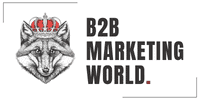
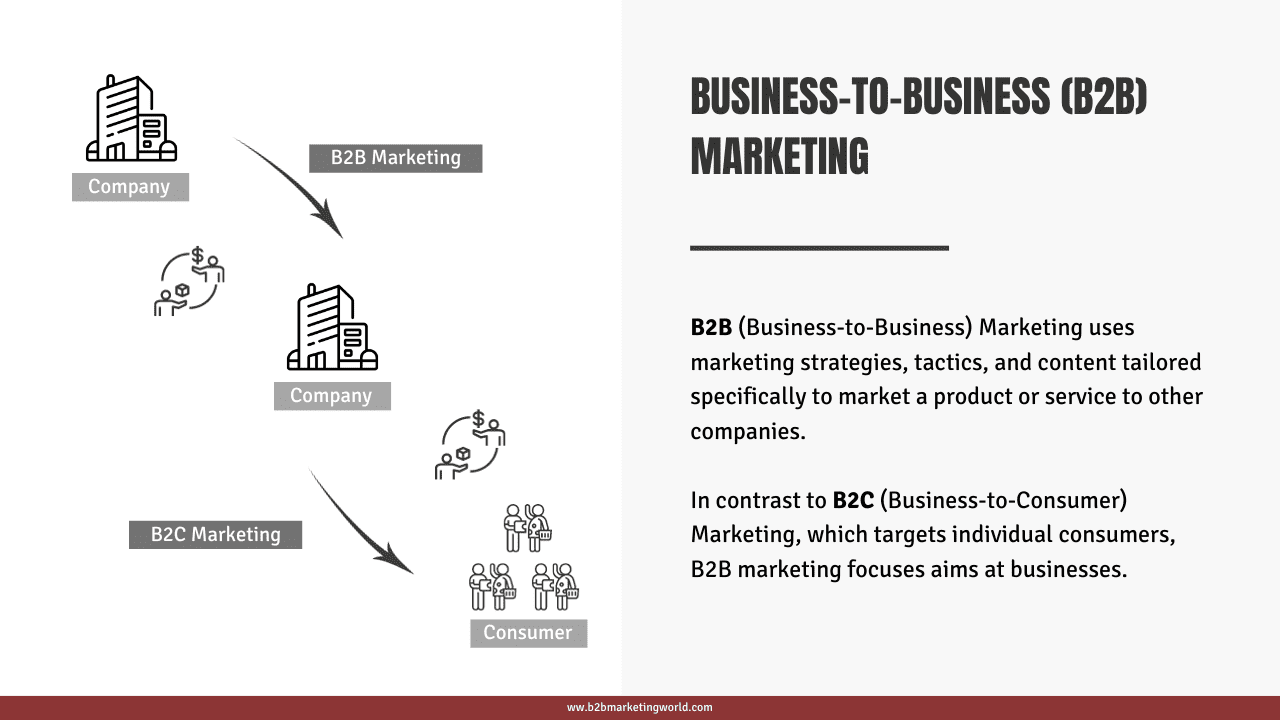
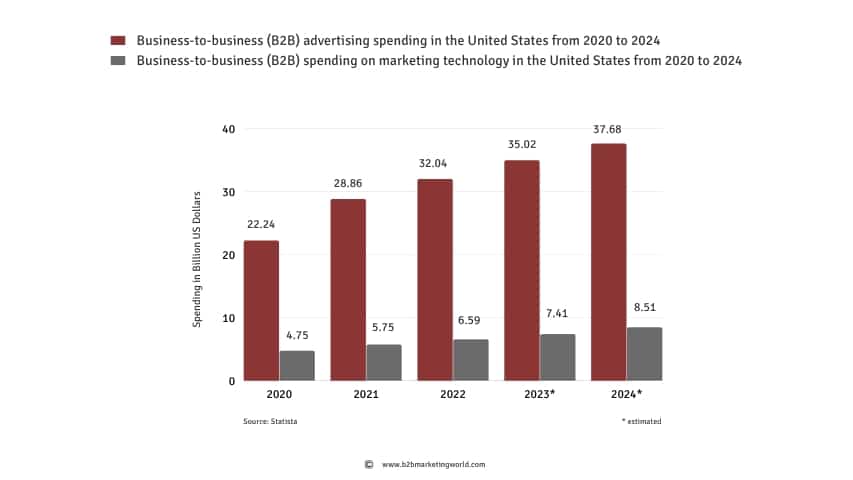
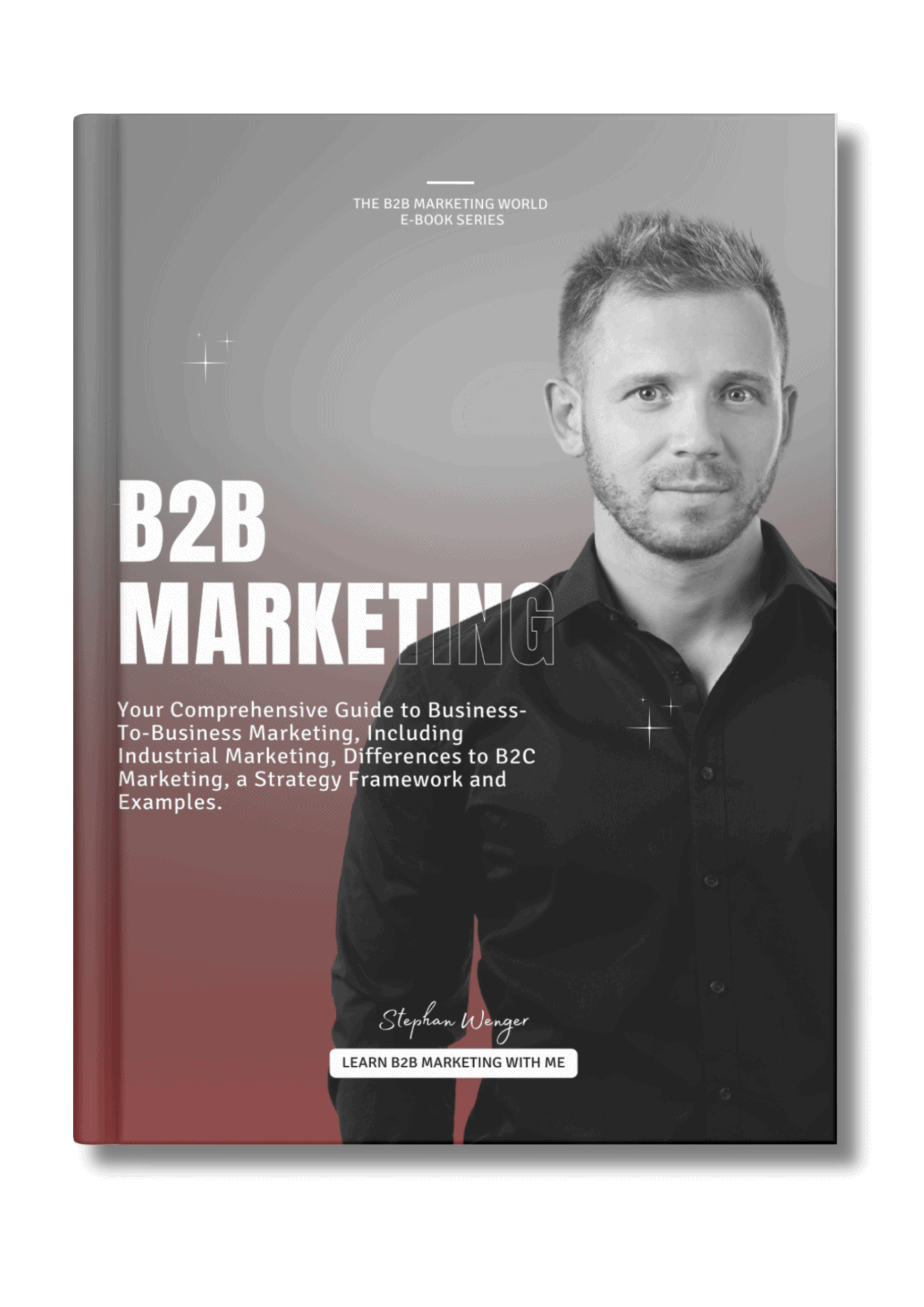
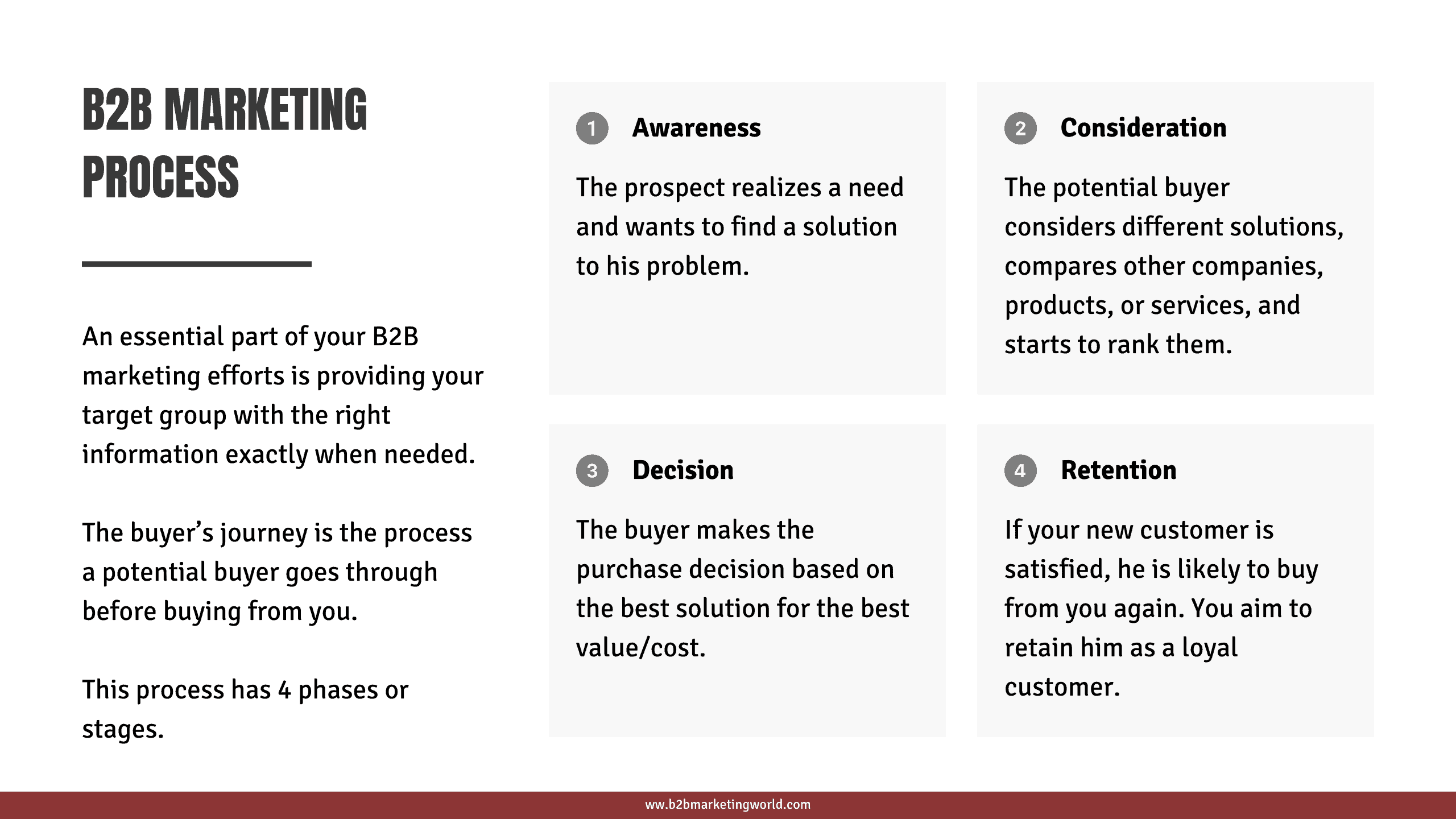



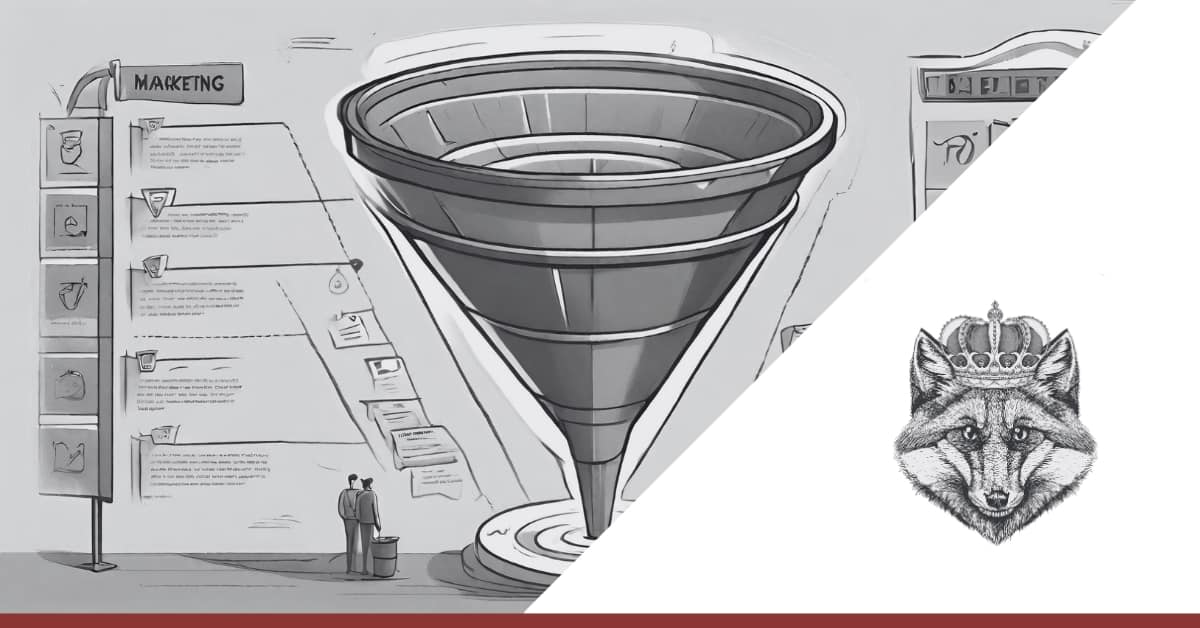



This is a great article for beginners wondering about B2B Marketing! Thank you.
Thank you very much for your kind and motivating feedback.